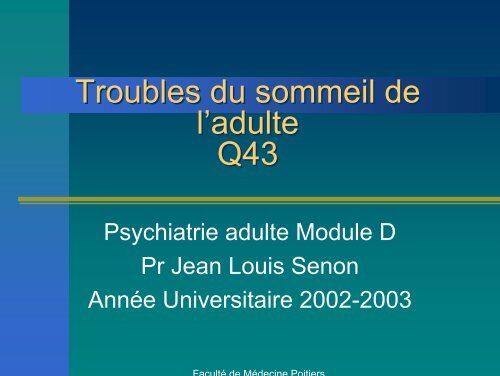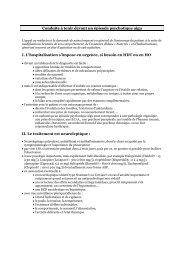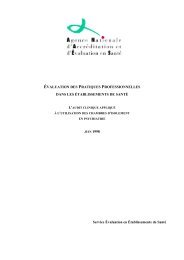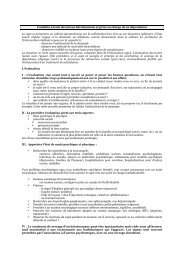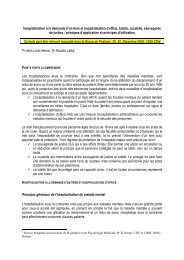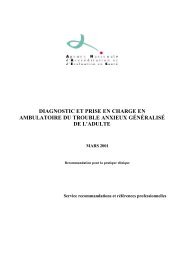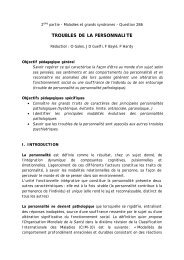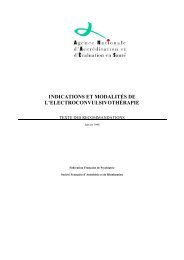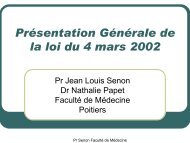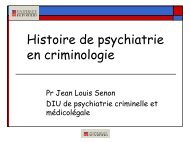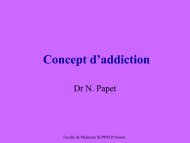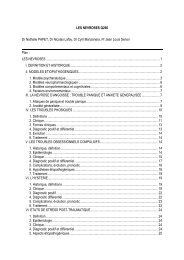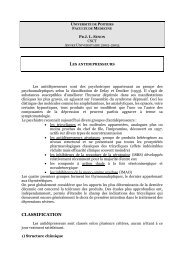Troubles du sommeil de l'adulte - Psychiatrie Adulte et Psychologie ...
Troubles du sommeil de l'adulte - Psychiatrie Adulte et Psychologie ...
Troubles du sommeil de l'adulte - Psychiatrie Adulte et Psychologie ...
- No tags were found...
You also want an ePaper? Increase the reach of your titles
YUMPU automatically turns print PDFs into web optimized ePapers that Google loves.
<strong>Troubles</strong> <strong>du</strong> <strong>sommeil</strong> <strong>de</strong>l’a<strong>du</strong>lteQ43<strong>Psychiatrie</strong> a<strong>du</strong>lte Mo<strong>du</strong>le DPr Jean Louis SenonAnnée Universitaire 2002-2003
Plans <strong>et</strong> objectifs• Sommeil normal, sta<strong>de</strong>s <strong>du</strong> <strong>sommeil</strong>• Examen d’un trouble <strong>du</strong> <strong>sommeil</strong>• Dyssomnies & parasomnies• Examen <strong>et</strong> con<strong>du</strong>ite à tenir <strong>de</strong>vant uninsomniaque• Classification <strong>de</strong>s insomnies• Hypersomnies spécifiques• Syndrome <strong>de</strong> Kline-Levin
Sommeil Normal• Quantité, qualité, fonction• Sta<strong>de</strong>s– Éveillé : bas voltage– Endormissement : alpha– Sta<strong>de</strong> I : thêta (3 à 7 cycles/s)– Sta<strong>de</strong> II : 12 à 14 cycles/s complexesK– Sommeil <strong>de</strong>lta : 1/2 à 2 cycles/s– Sommeil paradoxal
Sta<strong>de</strong>s <strong>du</strong> <strong>sommeil</strong>(Reschtschaffen & Kales)• Sta<strong>de</strong>s I <strong>et</strong> II : <strong>sommeil</strong> léger• Sta<strong>de</strong>s III <strong>et</strong> IV : <strong>sommeil</strong> lent profond• Sta<strong>de</strong> V : <strong>sommeil</strong> paradoxal (Rem :rapid eye movements)
Examen d ’un trouble <strong>du</strong> <strong>sommeil</strong> (1)• Quantité <strong>de</strong> <strong>sommeil</strong>– Heure <strong>et</strong> délai d ’endormissement– Éveils nocturnes : nombre, <strong>du</strong>rée fréquence– Heure <strong>de</strong> réveil– Durée totale• Qualité <strong>de</strong> <strong>sommeil</strong>– Endormissement : rapidité, facilité– Réveil : qualité, facilité– Appréciation subjective <strong>de</strong> la qualité réparatrice
Examen d ’un trouble <strong>du</strong> <strong>sommeil</strong> (2)• Vigilance diurne– Disponibilité intellectuelle <strong>et</strong> physique,– Somnolence, asthénie, caractère, humeur– Mémoire, concentration, attention• Hygiène <strong>de</strong> vie– Horaires <strong>de</strong> vie, régularité <strong>du</strong> coucher– Travail posté– Exercice physique, sport– Alimentation, repas <strong>du</strong> soir– Alcool, drogues, stimulants
Classification <strong>de</strong>s troubles <strong>du</strong> <strong>sommeil</strong>• Dyssomnies :– Insomnies– Hypersomnies– <strong>Troubles</strong> <strong>du</strong> rythme veille-<strong>sommeil</strong>• Parasomnies :– Cauchemars– Terreurs nocturnes– Somnambulisme
Classification <strong>de</strong>s insomnies• Insomnies occasionnelles• Insomnies chroniques– Insomnies psychophysiologiques– Insomnies organiques• Insomnies pharmacologiques– Insomnies médicamenteuses– Insomnies rebond
Classification <strong>de</strong>s hypersomnies• Hypersomnies in<strong>du</strong>ites– Syndrome d ’insuffisance <strong>de</strong> <strong>sommeil</strong>– Hypersomnies médicamenteusesAlcool, psychotropes, anticomitaux• Hypersomnies spécifiques– Syndrome d ’apnée <strong>de</strong> <strong>sommeil</strong>– Narcolepsie– Syndrome <strong>de</strong> Kleine-Levin– Hypersomnie idiopathique
<strong>Troubles</strong> <strong>du</strong> rythme circadien• Horaires <strong>de</strong> vie décalés– Travail posté– J<strong>et</strong>-lag• <strong>Troubles</strong> <strong>du</strong> rythme circadien <strong>du</strong><strong>sommeil</strong>– R<strong>et</strong>ard <strong>de</strong> phase <strong>du</strong> <strong>sommeil</strong>– Avance <strong>de</strong> phase <strong>du</strong> <strong>sommeil</strong>
Insomnie occasionnelle• Apparition récente• I<strong>de</strong>ntification <strong>de</strong> l ’événementdéclenchant– Deuil– Maladie– Examen– Difficultés familiales ou affectives• Pathologie transitoire
Insomnies chroniques• Insomnies psychophysiologiques– États <strong>de</strong> tension psychologiques <strong>et</strong>musculaire– Conditionnement négatif au <strong>sommeil</strong>• Insomnies organiques– IC <strong>et</strong> IR, douleurs– Impatiences <strong>de</strong>s membres inférieurs– myoclonie nocturne
Insomnies pharmacologiques• Insomnies médicamenteuses– Hypnotiques, tranquillisants,stimulants– Corticoï<strong>de</strong>s, antibiotiques, AINS• Insomnie rebond– Sevrage <strong>de</strong>s hypnotiques– Sevrage <strong>de</strong>s tranquillisants– Post-opératoire
Insomnies psychiatriques• Chez l ’anxieux– Insomnie d ’endormissement• Chez le phobique– Phobie d ’endormissement• Chez le déprimé– Insomnie <strong>de</strong> fin <strong>de</strong> nuit (réveil à 3h)• Chez le confus– Angoisse onirique <strong>de</strong> début <strong>de</strong> nuit
Parasomnies• Cauchemars– Rêve long <strong>et</strong> effrayant avec éveil terrorisé• Terreurs nocturnes– Éveil dans le premier temps <strong>de</strong> la nuit<strong>du</strong>rant le <strong>sommeil</strong> profond (st III <strong>et</strong> IV)– Désorientation, puis somnambulisme– Diagnostic différentiel : épilepsie temporale• Somnambulisme– Comportements moteurs (premier tiers nuit)
Hypersomnies spécifiques (1)• Syndrome d ’apnée <strong>du</strong> <strong>sommeil</strong> (SAS)– Ronflements, pauses respiratoires, apnées– Polyurie– Fatigue au lever• Narcolepsie, syndrome <strong>de</strong> Gelineau– Somnolence diurne avec accès <strong>de</strong><strong>sommeil</strong> irrésistibles– Cataplexie : dissolution brutale <strong>du</strong> tonus <strong>de</strong>posture avec inhibition <strong>de</strong> la motricité =>chutes
Hypersomnies spécifiques (2)• Syndrome <strong>de</strong> Pickwick :– Hypersomnie <strong>de</strong> l’obèse– Accès d’hypersomnie à tout moment <strong>et</strong> entout lieu quand l’attention n’est plussollicitée– Hypoventilation alvéolaire avec hypoxie,hypercapnie, cyanose <strong>et</strong> polyglobulie• Hypersomnies psychiatriques :– Dépressions– Névroses
Syndrome <strong>de</strong> Kleine-Levin• Crises <strong>de</strong> 1 à 4 semaines• Hypersomnie• Hyperphagie• Désinhibition sexuelle• Signes confusionnels, hallucinations• Début : 10 à 21 ans• Rémission spontanée vers 40 ans


